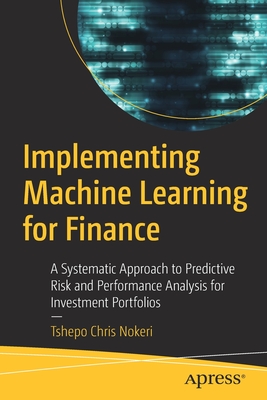Pattern Recognition in Industry (Hardcover)
暫譯: 工業中的模式識別 (精裝版)
Phiroz Bhagat
- 出版商: Morgan Kaufmann
- 出版日期: 2005-05-01
- 定價: $2,980
- 售價: 5.0 折 $1,490
- 語言: 英文
- 頁數: 200
- 裝訂: Hardcover
- ISBN: 0080445381
- ISBN-13: 9780080445380
-
相關分類:
Data-mining
立即出貨
買這商品的人也買了...
-
 Crafting a Compiler With C (IE-Paperback)
Crafting a Compiler With C (IE-Paperback)$1,250$1,225 -
 深入淺出設計模式 (Head First Design Patterns)
深入淺出設計模式 (Head First Design Patterns)$880$695 -
 深入淺出 Java 程式設計, 2/e (Head First Java, 2/e)
深入淺出 Java 程式設計, 2/e (Head First Java, 2/e)$880$695 -
 Microsoft Visual C# 2010 程式設計速學對策
Microsoft Visual C# 2010 程式設計速學對策$520$411 -
 Google API 大全-程式設計、開發、實例
Google API 大全-程式設計、開發、實例$580$458 -
 C How to program, 6/e (IE-Paperback)
C How to program, 6/e (IE-Paperback)$800$784 -
 計算機組織與設計 (Computer Organization and Design: The Hardware/Software Interface, 4/e)
計算機組織與設計 (Computer Organization and Design: The Hardware/Software Interface, 4/e)$900$855 -
 Android 4.X 手機/平板電腦程式設計入門、應用到精通, 2/e (適用 Android 1.X~4.X)
Android 4.X 手機/平板電腦程式設計入門、應用到精通, 2/e (適用 Android 1.X~4.X)$520$411 -
 Android 初學特訓班, 2/e (全新 Android 4 開發示範 / 適用 Android 4.X~2.X,手機與平板電腦的全面啟動,附影音教學/範例程式/小綠人素材)
Android 初學特訓班, 2/e (全新 Android 4 開發示範 / 適用 Android 4.X~2.X,手機與平板電腦的全面啟動,附影音教學/範例程式/小綠人素材)$480$379 -
 實戰封包分析-使用 Wireshark (Practical Packet Analysis: Using Wireshark to Solve Real-World Network Problems, 2/e)
實戰封包分析-使用 Wireshark (Practical Packet Analysis: Using Wireshark to Solve Real-World Network Problems, 2/e)$450$356 -
 Dreamweaver CS6 + PHP 商業資料庫網站整合設計
Dreamweaver CS6 + PHP 商業資料庫網站整合設計$650$514 -
JavaScript & jQuery: The Missing Manual 國際中文版, 2/e
$580$458 -
 Operating System Concepts With WileyPLUS Set, 8/e (IE-Paperback)
Operating System Concepts With WileyPLUS Set, 8/e (IE-Paperback)$1,300$1,274 -
 Debug Hacks 除錯駭客 -- 極致除錯的技巧與工具
Debug Hacks 除錯駭客 -- 極致除錯的技巧與工具$580$458 -
 Dreamweaver CS6 網頁製作比你想的簡單 !
Dreamweaver CS6 網頁製作比你想的簡單 !$450$356 -
 Computer Organization and Design: The Hardware/Software Interface, 4/e (IE-Paperback)
Computer Organization and Design: The Hardware/Software Interface, 4/e (IE-Paperback)$1,300$1,274 -
 跟 Adobe 徹底研究 Illustrator CS6 (Adobe Illustrator CS6 Classroom in a Book)
跟 Adobe 徹底研究 Illustrator CS6 (Adobe Illustrator CS6 Classroom in a Book)$650$553 -
 王者歸來-C# 完全開發範例集
王者歸來-C# 完全開發範例集$860$731 -
 Android 錦囊妙計 (Android Cookbook)
Android 錦囊妙計 (Android Cookbook)$980$774 -
 手機應用程式設計超簡單-APP Inventor 初學特訓班-入門、應用到上架全攻略
手機應用程式設計超簡單-APP Inventor 初學特訓班-入門、應用到上架全攻略$420$332 -
 演算法-使用 C++ 虛擬碼, 4/e (Foundations of Algorithms, 4/e)
演算法-使用 C++ 虛擬碼, 4/e (Foundations of Algorithms, 4/e)$680$537 -
 Android Apps 初學必修課 (適用 Android4.x~2.x)
Android Apps 初學必修課 (適用 Android4.x~2.x)$480$379 -
 精通 Objective-C 程式設計, 5/e (Programming in Objective-C, 5/e)
精通 Objective-C 程式設計, 5/e (Programming in Objective-C, 5/e)$580$458 -
 ASP.NET MVC 4 網站開發美學
ASP.NET MVC 4 網站開發美學$680$537 -
 Java SE 7 與 Android 4.x 程式設計範例教本, 2/e (附 Java 和 Android 範例專案)
Java SE 7 與 Android 4.x 程式設計範例教本, 2/e (附 Java 和 Android 範例專案)$540$427
商品描述
Description:
Two wave fronts are upon us today: we are being bombarded by an enormous amount of data, and we are confronted by continually increasing technical and business advances.
Ideally, the endless stream of data should be one of our major assets. However, this potential asset often tends to overwhelm rather than enrich. Competitive advantage depends on our ability to extract and utilize nuggets of valuable knowledge and insight from this data deluge. The challenges that need to be overcome include the under-utilization of available data due to competing priorities, and the separate and somewhat disparate existing data systems that have difficulty interacting with each other.
Conventional approaches to formulating models are becoming progressively more expensive in time and effort. To impart a competitive edge, engineering science in the 21st century needs to augment traditional modelling processes by auto-classifying and self-organizing data; developing models directly from operating experience, and then optimizing the results to provide effective strategies and operating decisions. This approach has wide applicability; in areas ranging from manufacturing processes, product performance and scientific research, to financial and business fields.
This monograph explores pattern recognition technology, and its concomitant role in extracting useful knowledge to build technical and business models directly from data, and in optimizing the results derived from these models within the context of delivering competitive industrial advantage. It is not intended to serve as a comprehensive reference source on the subject. Rather, it is based on first-hand experience in the practice of this technology: its development and deployment for profitable application in industry.
The technical topics covered in the monograph will focus on the triad of technological areas that constitute the contemporary workhorses of successful industrial application of pattern recognition. These are: systems for self-organising data; data-driven modelling; and genetic algorithms as robust optimizers.
Table of Contents:
Preface
Acknowledgments
About the Author
Part I Philosophy
CHAPTER 1: INTRODUCTION
CHAPTER 2: PATTERNS WITHIN DATA
CHAPTER 3: ADAPTING BIOLOGICAL PRINCIPLES FOR DEPLOYMENT IN COMPUTATIONAL SCIENCE
CHAPTER 4: ISSUES IN PREDICTIVE EMPIRICAL MODELINGPart II Technology
CHAPTER 5: SUPERVISED LEARNING—CORRELATIVE NEURAL NETS
CHAPTER 6: UNSUPERVISED LEARNING: AUTO-CLUSTERING AND SELF-ORGANIZING DATA
CHAPTER 7: CUSTOMIZING FOR INDUSTRIAL STRENGTH APPLICATIONS
CHAPTER 8: CHARACTERIZING AND CLASSIFYING TEXTUAL MATERIAL
CHAPTER 9: PATTERN RECOGNITION IN TIME SERIES ANALYSIS
CHAPTER 10: GENETIC ALGORITHMSPart III Case Studies
CHAPTER 11: HARNESSING THE TECHNOLOGY FOR PROFITABILITY
CHAPTER 12: REACTOR MODELING THROUGH IN SITU ADAPTIVE LEARNING
CHAPTER 13: PREDICTING PLANT STACK EMISSIONS TO MEET ENVIRONMENTAL LIMITS
CHAPTER 14: PREDICTING FOULING/COKING IN FIRED HEATERS
CHAPTER 15: PREDICTING OPERATIONAL CREDITS
CHAPTER 16: PILOT PLANT SCALE-UP BY INTERPRETING TRACER DIAGNOSTICS
CHAPTER 17: PREDICTING DISTILLATION TOWER TEMPERATURES: MINING DATA FOR CAPTURING DISTINCT OPERATIONAL VARIABILITY
CHAPTER 18: ENABLING NEW PROCESS DESIGN BASED ON LABORATORY DATA
CHAPTER 19: FORECASTING PRICE CHANGES OF A COMPOSITE BASKET OF COMMODITIES
CHAPTER 20: CORPORATE DEMOGRAPHIC TREND ANALYSIS
EPILOGUEAppendices
APPENDIX A1: THERMODYNAMICS AND INFORMATION THEORY
APPENDIX A2: MODELING
商品描述(中文翻譯)
描述:
今天我們面臨兩個波前:我們正被大量數據轟炸,並且面對不斷增加的技術和商業進步。
理想情況下,這無盡的數據流應該是我們的主要資產之一。然而,這個潛在的資產往往會使人感到不知所措,而不是豐富我們的知識。競爭優勢取決於我們從這場數據洪流中提取和利用有價值的知識和洞察的能力。需要克服的挑戰包括由於競爭優先事項而導致的可用數據的低利用率,以及現有數據系統之間的分離和某種程度的差異,這使得它們難以相互交互。
傳統的模型制定方法在時間和精力上變得越來越昂貴。為了獲得競爭優勢,21世紀的工程科學需要通過自動分類和自我組織數據來增強傳統建模過程;直接從操作經驗中開發模型,然後優化結果以提供有效的策略和操作決策。這種方法具有廣泛的適用性;涵蓋從製造過程、產品性能和科學研究到金融和商業領域的各個領域。
本專著探討了模式識別技術及其在從數據中提取有用知識以直接構建技術和商業模型中的伴隨角色,以及在提供競爭工業優勢的背景下優化這些模型所產生的結果。它並不打算作為該主題的全面參考來源。相反,它基於在該技術實踐中的第一手經驗:其在行業中開發和部署以獲取利潤的應用。
本專著涵蓋的技術主題將集中在構成當代成功工業應用模式識別的三個技術領域。這些是:自我組織數據的系統;數據驅動建模;以及作為穩健優化器的遺傳算法。
目錄:
前言
致謝
關於作者
第一部分 哲學
第一章:介紹
第二章:數據中的模式
第三章:適應生物原則以用於計算科學
第四章:預測性經驗建模中的問題
第二部分 技術
第五章:監督學習—相關神經網絡
第六章:非監督學習:自動聚類和自我組織數據
第七章:為工業強度應用定制
第八章:特徵化和分類文本材料
第九章:時間序列分析中的模式識別
第十章:遺傳算法
第三部分 案例研究
第十一章:利用技術實現盈利
第十二章:通過原位自適應學習進行反應器建模
第十三章:預測工廠堆疊排放以滿足環境限制
第十四章:預測燃燒加熱器中的污垢/焦化
第十五章:預測操作信用
第十六章:通過解釋示蹤診斷進行試點工廠擴大
第十七章:預測蒸餾塔溫度:挖掘數據以捕捉明確的操作變異性
第十八章:基於實驗室數據啟用新工藝設計
第十九章:預測一籃商品的價格變化
第二十章:企業人口統計趨勢分析
後記
附錄
附錄 A1:熱力學與信息理論
附錄 A2:建模































